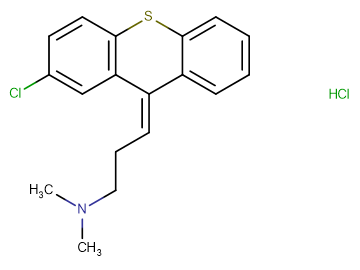
Chlorprothixene hydrochloride
CAS No. 6469-93-8
Chlorprothixene hydrochloride( cis-Chlorprothixene | NSC 169899 )
Catalog No. M15453 CAS No. 6469-93-8
Chlorprothixene is a typical antipsychotic drug of the thioxanthene (tricyclic) class.
Purity : >98% (HPLC)
 COA
COA
 Datasheet
Datasheet
 HNMR
HNMR
 HPLC
HPLC
 MSDS
MSDS
 Handing Instructions
Handing Instructions
| Size | Price / USD | Stock | Quantity |
| 25MG | 29 | In Stock |


|
| 50MG | 45 | In Stock |


|
| 100MG | 61 | In Stock |


|
| 200MG | 80 | In Stock |


|
| 500MG | Get Quote | In Stock |


|
| 1G | Get Quote | In Stock |


|
Biological Information
-
Product NameChlorprothixene hydrochloride
-
NoteResearch use only, not for human use.
-
Brief DescriptionChlorprothixene is a typical antipsychotic drug of the thioxanthene (tricyclic) class.
-
DescriptionChlorprothixene is a typical antipsychotic drug of the thioxanthene (tricyclic) class. Chlorprothixene exerts strong blocking effects by blocking the 5-HT2 D1, D2, D3, histamine H1, muscarinic and alpha1 adrenergic receptors. (In Vitro):Chlorprothixene binds to 5-HT receptors with pKis of 8.3, 8.5, and 9.4 for 5-HT7, 5-HT6 and 5-HT2, respectively.
-
In Vitro——
-
In Vivo——
-
Synonymscis-Chlorprothixene | NSC 169899
-
PathwayEndocrinology/Hormones
-
Target5-HT Receptor
-
Recptor5-HT| mAChR| Dopamine| H1 receptor
-
Research Area——
-
Indication——
Chemical Information
-
CAS Number6469-93-8
-
Formula Weight352.32
-
Molecular FormulaC18H18ClNS·HCl
-
Purity>98% (HPLC)
-
SolubilityDMSO: 10 mM
-
SMILESCN(C)CC/C=C\1/C2=CC=CC=C2SC3=C1C=C(C=C3)Cl.Cl
-
Chemical Name——
Shipping & Storage Information
-
Storage(-20℃)
-
ShippingWith Ice Pack
-
Stability≥ 2 years
Reference
1.Froimowitz M, Cody V. J Med Chem. 1993 Jul 23;36(15):2219-27.
molnova catalog



related products
-
Eucalyptol
Eucalyptol inhibits 5-HT-evoked currents in oocytes expressing 5-HT3 receptors with an IC50 of 258 μM.
-
DOV 21947 hydrochlor...
Amitifadine hydrochloride is a triple reuptake inhibitor (TRI) or serotonin-norepinephrine-dopamine reuptake inhibitor (SNDRI).
-
Blonanserin
Blonanserin is a novel atypical antipsychotic agent with potent dopamine D2 and serotonin 5-HT2 receptors antagonist properties.



 Cart
Cart
 sales@molnova.com
sales@molnova.com


